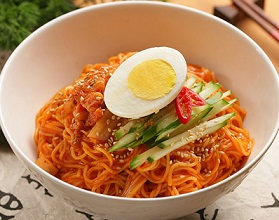 |
| |
BI-BIM GUK-SU
Sweet & Spicy Cold Noodles 비빔국수 | ||
Bibim guksu, a cold dish made with very thin wheat flour noodles called somyun with added flavorings, is one of the most popular traditional noodle dishes in Korean cuisine. It is also called guksu bibim which literally mean stirred noodles or mixed noodles. The dish is especially popular during the summer season much like another similar Korean noodle dish called jjolmyun.
There are many kinds of cold noodle dishes in Korea, including one made with cold beef broth; however, spicy cold noodles have historically been appreciated by spicy food lovers in Korea and also recognized internationally. What makes this dish so distinct from other cold noodle dishes from different cultures is the strong spicy flavor produced from the combination ofgochugaru (red chili pepper flakes), gochujang (red chili pepper paste), and minced garlic, along with a sweet-and-sour flavor created by vinegar and sugar. Most spicy cold noodles are prepared with a slight touch of sesame oil to enhance the richness of its flavor.
Typically the dish would be prepared by stir frying diced beef, julienned pickled cucumbers, and mushrooms in sesame oil, which is all mixed together with the cooked noodles, soy sauce, sesame oil, sesame seeds and sugar. Garnishes placed on top and around the spicy noodles include hard-boiled eggs, pickled radish, dried layer strips, cabbage, sesame leaves, and sometimes sliced Korean pear.
|
| FEATURED ITEMS: CLICK & SHOP |
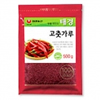 | 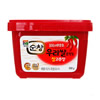 | 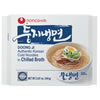 | 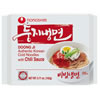 |
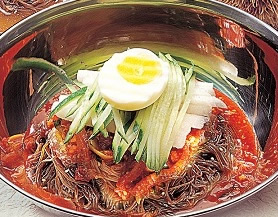 |
| |
BIBIM
NAENG-MYUN Spicy Buckwheat Noodles 비빔냉면 | ||
Bibim naeng myun is another popular noodle dish that is enjoyed by spicy food lovers, especially during the hot summers. It's basically a spin off of naeng myun where it's served with a spicy dressing made primarily from gochujang (red chili pepper paste) and eaten all mixed together. A bowl of the soup broth used in mul naengmyeon or plain broth from the boiled noodles itself are often served on the side as a complimentary soup.
Aside from it's spiciness, its ingredients are very similar to regular naeng myun, which consists of thin noodles typically made from arrowroot or buckwheat flour, garnished with slice of beef or pork, a boiled half egg, Asian pear, and cucumbers. Some restaurants place crushed ice cubes as opposed to chilled nooldes in a metallic bowl.
|
| FEATURED ITEMS: CLICK & SHOP |
 |  | 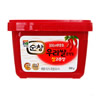 |
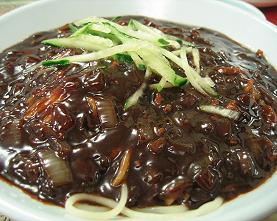 |
| |
CHA-JANG MYUN
Black Bean Paste & Vegetable Noodles 자장면 | ||
Chajang myun is another popular noodle dish enjoyed by many Asians. Most Koreans consider this meal a Chinese dish and it is usually only found in Korean/Chinese restaurants.Chajang is the sauce made from black bean paste which gives its distinctive black color andmyun means noodle. The final chajang sauce contains onion, meat and/or seafood, usually squid, shrimp, sea cucumber and others but never any fish ingredients. Some starch is added to give it a thick consistency and it is served over noodles.
Another common dish using this chajang sauce is chajang-bop which is the chajang sauce served over bop which means steamed, short-grain rice (usually white). Common side dishusually found alongside chajang myun or chajang bop is donmoogee which is a delicious pickled daikon radish.
Instant packages of chajang myun can be purchased at Korean supermarkets or even at local delicatessen. To see all brands of instant noodles, click here.
|
| FEATURED ITEMS: CLICK & SHOP |
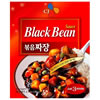 | 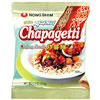 |
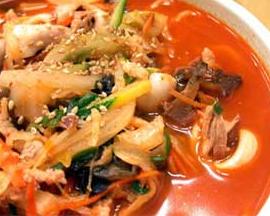 |
| |
CHAM-PONG
Spicy Seafood Noodle 짬뽕 | ||
Champong is a popular noodle dish that is prepared in a red, spicy seafood broth containing hearty vegetables and variety of seafood. This dish presumably has its origins in Japan with influence from China and is known to be very popular at various restaurants or even at homes. Instant noodle versions are also popular which can be prepared within minutes.
However, to enjoy this authentic dish, many Koreans go to Korean/Chinese restaurants where noodles are mixed in with real seafood such as squids, shrimps, clams and scallions. Fresh vegetables such as onions, red peppers, green onions as well as many others are included in this dish to compliment the spiciness of the base soup. Champong is considered to be mild to high in spiciness so expect to sweat while consuming this dish.
Instant packages of champong can be purchased at Korean supermarkets or even at local delicatessen. To see all brands of instant noodles, click here.
|
| RECIPE INGREDIENTS |
|
| COOKING DIRECTIONS |
|
| FEATURED ITEMS: CLICK & SHOP |
 |  |  |  |  |
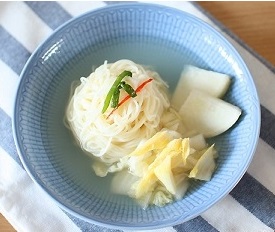 |
| |
DONG-CHIMI GUK-SU
Radish Water Kimchi Noodle 동치미국수 | ||
Dongchimi guksu is a popular noodle dish enjoyed by Korean especially during the colder seasons. As the name dong literally means "winter" in Korean and chimi is another term forkimchi, this noodle dish is traditionally consumed during winter. It's essentially wheat or buckwheat noodles in a bowl of cold dongchimi which is a variety of kimchi consisting of daikon, half-boiled egg, baechu (Chinese cabbage), scallions, fermented green chili, ginger, bae (Korean pear) and watery brine. The bowl may also contain ice to keep its broth nice and chilled.
Dongchimi is fermented like other varieties of kimchi's, but its maturing period is relatively short, about 2 to 3 days. Red peppers are also used, but dongchimi has a less spicy taste than other types of kimchi and radish is the most important ingredient. It may also include leaf mustard, garlics, gingers, leeks as well as other salted ingredients. Also, the clear and clean taste of the watery dongchimi can be used to make naengmyun or just served with tteok and/or steamed sweet potatoes to balance out the rich flavors.
|
| FEATURED ITEMS: CLICK & SHOP |
 |  |  |  |  |
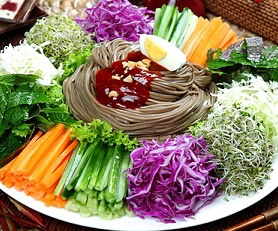 |
| |
JANG-BAN-GUK-SU
Spicy Buckwheat Noodles W/ Vegetables 쟁반국수 | ||
Jangban guksu is a healthy and delicious noodle dish mixed with assortment of vegetables. Buckwheat noodles are mixed in with perilla/sesame leaves, cucumbers, lettuce, cabbage, and carrots in a zesty spicy sauce called chojang. Chojang comprises of watered downgochujang mixed with chopped green onions, rice vinegar, sesame seed and sesame oil.
Different variation of this noodle dish exist, including a non-spicy version in which gochujang is substituted with soy sauce along with other ingredients as its base sauce. Additionally, thin strips of Asian pear can be added for additional mixture in taste as well as a boiled egg for garnish.
|
| RECIPE INGREDIENTS |
|
| COOKING DIRECTIONS |
|
| FEATURED ITEMS: CLICK & SHOP |
 | 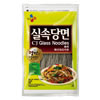 |  |  |
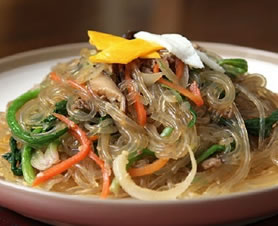 |
| |
JAP-CHAE
Vermicelli Noodles 잡채 | ||
Japchae is a stir-fried dish that combines sweet vermicelli noodles made from the starch of a white sweet potato, thinly slices of beef, and various vegetables. It is usually prepared with carrots, green onion, spinach, shiitake mushrooms and green peppers. Beef may be added as an option but may be left out to be served as a vegetarian dish. The noodles are gray when raw and turn almost translucent when cooked (thus given its popular nickname, glass noodles). When cooked correctly, they retain a chewy texture.
Japchae is often served at Korean parties and during special occasions as the main dish or as a side dish. It can be added to a bed of rice and mixed together to make japchaebop, bopmeaning rice.
|
| RECIPE INGREDIENTS |
|
| COOKING DIRECTIONS |
|
| FEATURED ITEMS: CLICK & SHOP |
 |  |  |
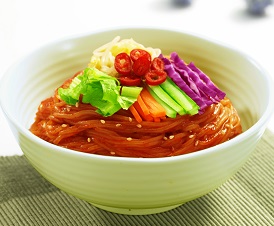 |
| |
JJ-OL-MYUN
Spicy Chewy Noodles 쫄면 | ||
Jjolmyun refers to either a type of Korean noodles that have a very chewy texture and are made from wheat flour and starch or a cold and spicy dish made with the noodles, half boiled egg, and vegetables. Vegetables may include but not limited to cucumber, carrots, bean sprouts and shredded cabbage. The spicy and hot sauce is a combination of gochujang (chili pepper paste), vinegar, sugar, and minced garlic. It is also a type of bibim guksu, also known as mixed noodles in Korean and it's especially popular during the summer season.
This dish is one of the most popular noodle dishes in South Korea, especially among young people at bunsikjeom or Korean snack restaurant. It is a representative dish of Incheon, where it originated in the early 1970s by mistake while attempting to make naengmyun.
|
| FEATURED ITEMS: CLICK & SHOP |
 |  |  |
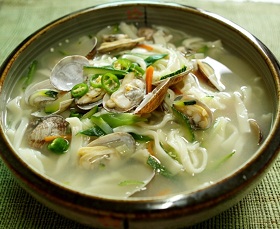 |
| |
KAL-GUK-SU
Wheat Noodle Soup ("Knife Soup") 칼국수 | ||
Kal guksu literally means "knife noodles" in Korean and the name comes from the fact that its noodles are cut rather than extruded or spun. It consists of handmade, knife-cut wheat flour noodles served in a large bowl with broth and other ingredients. The noodles are made with dough from wheat flour and eggs, sometimes containing ground bean powder for additional texture. The dough is usually left to "breathe" then rolled out thinly to be cut into long strips.
The broth is usually made with dried anchovies, shellfish, and kelp but chicken broth can be used as a substitute. Very similar to sujebi, ingredients are simmered together for many hours in order to obtain its rich flavor. It consists of similar vegetable and seafood contents such as zucchini, potatoes, scallions, clams and shrimps. Usually seasoned with salt, the noodles are served with garnish of choice and it is traditionally considered a seasonal food, consumed most often during summer.
|
| FEATURED ITEMS: CLICK & SHOP |
 |  |  |  |  |
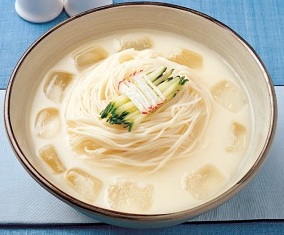 |
| |
KONG-GUK-SU
Chilled Soy Milk Noodle Soup 콩국수 | ||
Kong guksu is a popular vegetarian friendly, summer noodle dish served in a chilled soybean broth. In Korean, kong means bean, while guksu is another word for noodle. The noodle is usually made with wheat flour adding to the chewiness and soup made from ground soybeans which results in a thick, milky and creamy consistency. Some may add additional creamers and other ingredients to make the soy milk broth even thicker and creamier. Much likekalguksu ("knife" soup), kong guksu is made from the exact same wheat noodle but it is submerged in its cool broth, sometimes containing additional ice to keep it nice and chilled whereas kal guksu has a clear, usually seafood-based broth, served hot.
There are many variations of this dish but traditionally, it contains a refreshing hearty bowl filled with wheat noodles, soy milk, cucumbers, and ground peanuts or pine nuts. Other variation may contain parboiled potato, pear and other vegetables or even fruits such as watermelon.
|
| FEATURED ITEMS: CLICK & SHOP |
 |  |  |  |  |
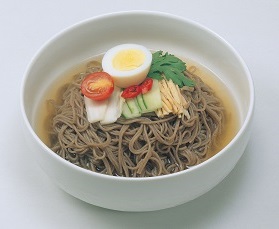 |
| |
MAK GUK-SU
Buckwheat Noodles In Chilled Broth 막국수 | ||
Mak guksu is a Korean buckwheat noodle dish served in a chilled chicken broth, sometimes served with sugar, mustard, sesame oil or vinegar. It is closely related to naeng myun but the differences lie in the high concentration of buckwheat flour in its noodles and the use of greater amounts of vegetables. The dish gets its name "rough noodles" from the fact that the buckwheat used is generally unhulled.
Mak guksu is usually prepared directly from buckwheat crop, soaked, and ground into a paste. Since buckwheat is less glutinous than most grains, buckwheat flour is particularly difficult to knead, roll, and slice into noodles by hand; thus, the noodles are often created in a hand-cranked noodle-making machine instead.
It's difficult to generalize for mak guksu's accompanying ingredients. Ingredients are traditionally determined by the customer rather than the restaurant owner, and many restaurants also carry their own unique flavoring recipes. In most cases, mak guksu is very spicy, sometimes seasoned with gochujang (hot pepper paste) and various types of kimchi can be added as well. Many recipes may also add various vegetables and/or soy sauce but frequently accompanied by boiled slices of beef or pork meat.
|
| FEATURED ITEMS: CLICK & SHOP |
 |
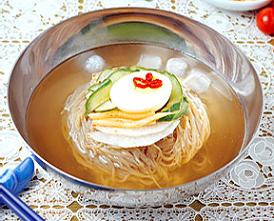 |
| |
NAENG-MYUN
Buckwheat Noodles 냉면 | ||
Naeng myun literally means cold noodles and it is one of Koreans favorite dishes during the summer. It consists of thin noodles typically made from arrowroot or buckwheat flour, and is served in a large bowl with a tangy iced broth. It is garnished with sliced beef or pork, a boiled half egg, slices of Asian pear, and sliced cucumber, sprinkled with chopped scallions and sesame seeds.
Two main varieties of naeng myuns exists: mul naeng myun and bibim naeng myun. The former variety is served as a cold soup with the noodles contained in broth (usually beef). The latter variety is served as more of a salad in a spicy dressing made primarily from gochujangwhich is red chili pepper paste. Although these are the two major variations of this dish, several others do exist, typically varying either in the composition of the broth, meat or vegetables. Also, traditionally, the broth for naeng myun is made with about ⅓ beef broth, ⅓ chicken broth, and ⅓ kimchi brine. But because few people have easy access to all three components, most Koreans use just beef broth or chicken broth.
Since naeng myun is a cold dish as indicated by its name, you would think that it is popular mainly during the summer, but many people enjoy it during the winter as well. There are manyrestaurants that specialize only in this dish so be sure to try the mild mul naeng myun before sampling the spicier bibim naeng myun.
|
| RECIPE INGREDIENTS |
|
| COOKING DIRECTIONS |
|
| FEATURED ITEMS: CLICK & SHOP |
 |  |  |
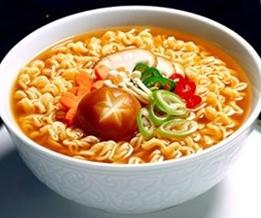 |
| |
SHIN RA-MYUN
Spicy Ramen Noodle 신라면 | ||
Shin ramyun is a staple noodle soup with a traditional spicy taste for all Asians worldwide. It is very easy to prepare yet a satisfying meal which can be prepared within ten minutes. All the ingredients are found within the package and additional ingredients such as kimchi, egg, green onions can be added to enhance its flavors and texture.
Nong Shim, the manufacturer of Shin ramen first introduced its noodles in 1986 and it is known to be very popular in Japan, US, Hong Kong, Taiwan and China. Other popular ramyuns (or ramens) from Nong Shim are Neoguri and Kimchi ramyun. To see other brands of instant noodles, click here.
Fact: Nong Shim noodles are considered to be one of the top selling ramyun in the world.
|
| RECIPE INGREDIENTS: FOUND IN PACKAGE |
|
| COOKING DIRECTIONS |
|
| FEATURED ITEMS: CLICK & SHOP |
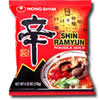 | 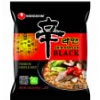 | 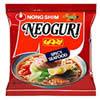 | 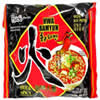 | 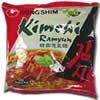 |
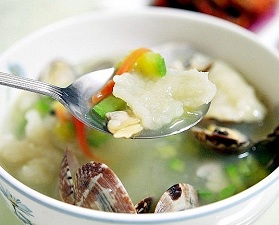 |
| |
SU-JE-BI
Hand-Torn Noodle Soup 수제비 | ||
Sujebi is a traditional soup in Korea consisting of dough flakes that are roughly torn by hand as opposed to being extruded or spun. The flavor and recipe resemble kalguksu but its noodles are made with all purpose flour rather than wheat. It contains hearty vegetables such as zucchini, potatoes, onions, chili peppers and scallions and it's favored on rainy days especially at home. The broth for this soup is usually made with dried anchovies, shellfish and kelp which are all simmered for many hours in order to obtain its rich flavors.
In the past, sujebi was relatively rare and eaten during special occasions such as the celebration of a baby's first birthday. But nowadays, it is considered a typical commoner's food for its simplicity in incredients as well as cost. The name of this dish varies according to regions in Korea and different content variations does exist, containing seafood such as clams and/or shrimps.
|
| FEATURED ITEMS: CLICK & SHOP |
 |  |  |  |  |
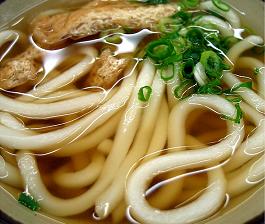 |
| |
U-DON
Wheat Noodle 우동 | ||
Udon is a popular instant or homemade noodle dish in both Korea and Japan. It is a type of thick, wheat-based noodle, usually served in a mildly flavored broth which is seasoned with soy sauce and mirin. Common toppings include tempura, often shrimp or fish cake, or a type of deep-fried tofu pockets seasoned with sugar, mirin, and soy sauce. A thin slice of half moon-shaped fish cake is often added, topped with thinly chopped green onions as well.
Unlike ramyun, udon has mild flavors and it can contain dried seaweeds. So if one doesn't prefer spicy noodles, udon is the perfect substitute dish. However, both types of noodles have delicious broths which are considered to be very refreshing in taste. The flavor of broth and topping may vary from region to region in Asia. This is even noticeable in packaged instant udon noodles, which are often sold in different versions depending on the geography.
Fact: The original udon noodle was 2-3 centimeter in diameter, a flat pancake-shaped noodle added to miso-based soup. It is said to have been imported to Japan from China in the 6th century.
|
| FEATURED ITEMS: CLICK & SHOP |
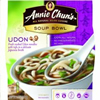 |
No comments:
Post a Comment